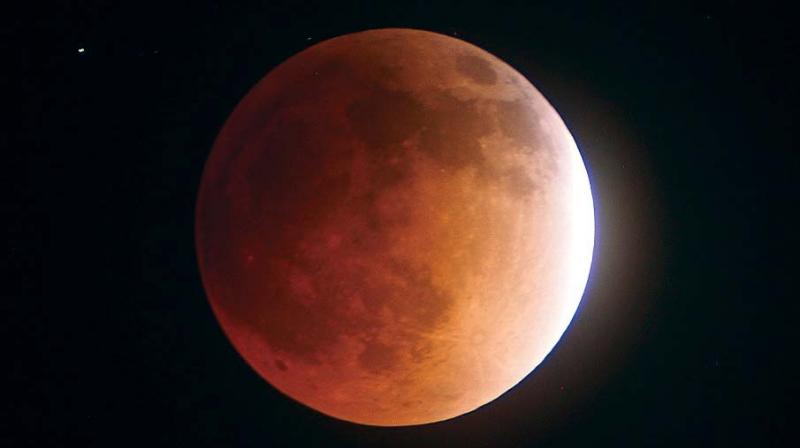Blood Moon rising!

Bengaluru: The rare full moon of 2018, which is being referred to as blue moon, super moon and blood moon, can be seen on Wednesday evening.
The unusual "super blue blood moon", which will be at its closest point to earth on Wednesday, will also experience an eclipse. The last time all the three astronomical elements came together was in 1866. When the moon is closest to the earth, it appears bigger and brighter and Wednesday's super moon will be 30% brighter and 14% bigger than the normal moon.
Jawaharlal Nehru Planetarium Director Pramod G. Galagi said, “We can see the total red moon rising, which will not be in the horizon like normal days. It also happens to be an eclipse because the moon will be very close to the perigee.”
At what time is eclipse?
The moon will reach the perigee at 5.18 pm (umbral phase) and the distance from the earth and moon will be closer by 3,000-4,000 km at 3,62,600 km. Totality begins at 6.21 pm (visible to the naked eye) and ends at 7.38pm. The moon leaves the umbra at 8.42 pm.
"This full moon happens to be the second full moon this month and that is why it is called the blue moon. Usually it is seen rising from the east, but this time we are expecting it to be slightly north-east. However, the moon does not appear blue, but will be larger in size,” he said.
Planetarium all set
Jawaharlal Nehru Planetarium has made special arrangements to observe the lunar eclipse from 6.30 pm to 8.30 pm. There will be five to six telescopes along with two binoculars which will be open for public.
Since it’s the lunar eclipse, it can be seen through the naked eye.
“We will assemble at Jawaharlal Nehru Planetarium on Wednesday to help the public. There will be a minimum of 8-10 volunteers, who will explain the phenomenon to the public,” said Jayanth B., president, Association of Bangalore Amateur Astronomers.
How rare is lunar eclipse?
Dr Sugatha, a senior scientist and in-charge of Birla Research Institute, said, “Super moon or the red moon is very rare. This combination occurs only once in 150 years. This is the second full moon in the month and that is why it is called ‘Blue Moon’ and it be completely eclipsed. It looks red because the earth shadows the moon.”
Schools to raise awareness
Some schools have decided to create awareness, while others said students may find it difficult as the event is in the evening.
“We will create awareness about the eclipse during morning classes and also organise some competitions. The eclipse is in the evening, so we can’t ask teachers and students to come to school at that time,” said Likith Raj, administrative officer of Euro School.
While the Principal from Delhi Public School (North) Manju Balasubramanium said, “We don’t have such plans because the event happens only late in the evening.”
Will see more wars
“Since it’s one of the rarest eclipses to occur, it will definitely have a major impact across the globe. There will be major conflicts and confusion which will lead to wars. Natural disasters might also occur and the population might face problems,” said astrologer Somayaji K.N.

